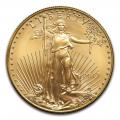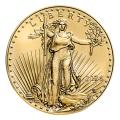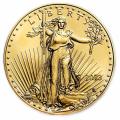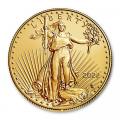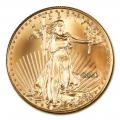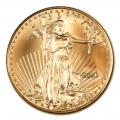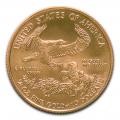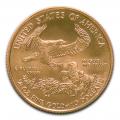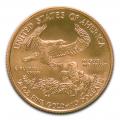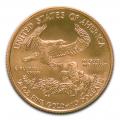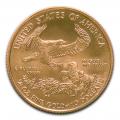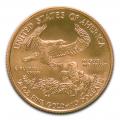Quarter Ounce Uncirculated American Gold Eagles
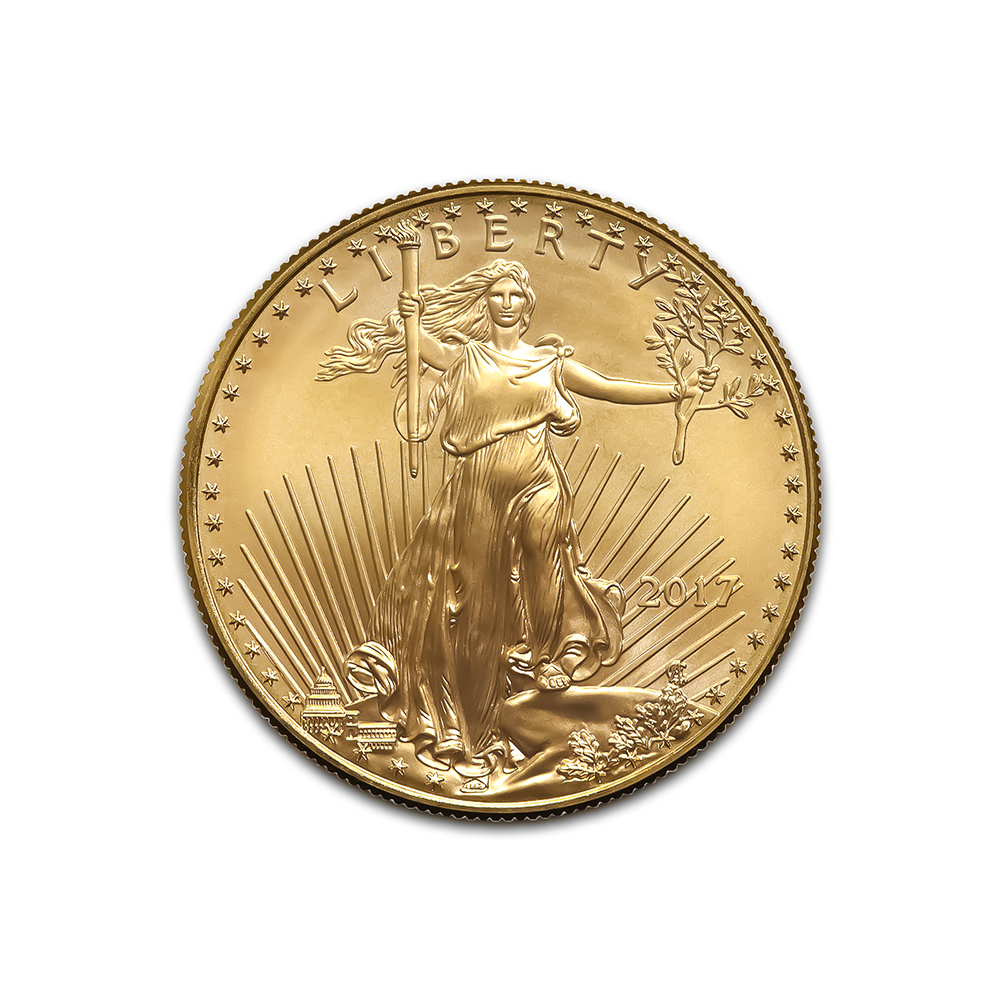
The American Gold Eagle is the United States' official gold bullion coin and remains an homage to one of the most influential gold coins in the nation's history. The obverse follows the artistic design created by Augustus Saint-Gaudens, for the $20 Gold Double Eagles, issued from 1907-1933. Saint-Gaudens was exclusively picked by president, Theodore Roosevelt, to design an image that would be a part of US history, while also reinvigorating US gold coinage.
Since the passage of the Gold Bullion Act of 1985, the American Gold Eagle Bullion coins have been diligently produced each year. Ronald Reagan signed the bill into action, forever changing the US precious metals industry. The first American Eagle was released in 1986 and was offered in sizes of 1 oz, 1/2 oz, 1/4 oz, and 1/10 oz.
American Gold Eagles are produced annually, by the US Mint, and carry the same design year after year. In order to preserve the crispness of the strike, the US Mint throws out the dies every year, and makes brand new ones for the succeeding year. The American Gold Eagles are 22-karat pure, containing an alloy of silver and copper lending to the coin's resistance to wear. Compared to other gold bullion coins, the American Gold Eagle is a larger and stronger coin.
Design of the American Gold Eagle
Repurposed in 1986 for the American Gold Eagle, the infamous design was created by Augustus Saint-Gaudens in 1907. The American Gold Eagle coin program rivals other popular gold coin series worldwide. Each coin is guaranteed by the US Mint and Treasury for it's weight and purity. The Lady Liberty design has been used as a symbol of patriotism since the US began minting their own currency and her message of courage and power still reigns true. Dressed in a light robe, Lady Liberty is depicted as a warrior, with only a torch and an olive branch as her weapons. The word, "Liberty," is written above her head, and 50 small stars encircle the coin's rim.
As per the country's Founding Fathers' request, the Bald Eagle became the nation's emblem; representing strength, independence, and leadership. Miley Busiek features a Bald Eagle family, on the reverse of the American Gold Eagle; a male, female, and a hungry baby. The representation of these three eagles depicts the country's strength,in the past, present, and future. The king of the birds of prey nests within a bed made of olive branches with the coin's weight, purity, and monetary value written underneath the eagle family.
Background of the American Gold Eagle
The American Gold Eagles are the first gold coins to be minted since 1933, in the United States. When the Gold Bullion Act of 1985 was passed, the legislation demanded that there would be four weight sizes offered and two different types of coins minted. This resulted in the American Gold Eagle containing the 1 oz, 1/2 oz, 1/4 oz, and 1/10 oz in sizes. There were also two conditions minted, brilliant uncirculated and proof (although the proof condition was only offered in 1 oz increments at first). The legislation also specified that the precious metals used, in the making of the American Gold Eagle, would come from US mines.
Many people confuse the American Gold Eagles with the "double eagles" of the Pre-1933 gold coin program. The double eagles are the $10 gold coins that once held the title of highest monetary value gold coin. In the 1820's and 30's, Congress was asked, on multiple occasions, to authorize the minting of a new gold coin. During the famous gold rushes, there were very large transactions taking place that would leave traders and prospectors with pockets full of small denomination gold coins. This system was neither safe or ideal for anyone so a larger denomination gold coin was the only answer. The $20 Liberty was first produced in 1850, maintaining its design until 1907, when the $20 Saint-Gaudens design took over.
Production of the American Gold Eagle
The American Gold Eagle coin program rivals other popular gold coin series worldwide. Each coin is guaranteed by the US Mint and Treasury for it's weight and purity. The US Mint prides itself on the high quality and precise production value of the American Gold Eagle. To make the perfect coin, the process is extremely meticulous. The process begins with a blank put through a spinning drum. When that blank comes out, on the other end, a specialist handles the coin with white gloves to ensure maximum care. The coin is then placed, by hand, into the coin press, where a high pressure strike is released. The individualized care, per coin, results in a clean, crisply minted product. Investors and collectors are aware of the caution that is used minting the American Gold Eagle, making it the official bullion coin in the United States.
The American Gold Eagle minting process varies slightly depending on the ideal finish of the coin. There are three finishes offered for the 1/4 oz American Gold Eagle Bullion coins.
- Brilliant Uncirculated: Each American Gold Eagle, in every size increment, is offered in BU condition. Brilliant Uncirculated condition is when a coin maintains its original mint luster since it wasn't placed in circulation, although it was intended for it.
- Proof: The Proof American Gold Eagles were minted, in just 1 oz increments, in 1986. By 1988, the Proof American Gold Eagle Coin became available in four sizes: 1 oz, 1/2 oz, 1/4 oz, and 1/10 oz. Unlike its brilliant uncirculated counterpart, the Proof American Gold Eagle's packaging is more aesthetically pleasing. The coin itself is encased in an appropriately fitted capsule then placed into a velvet presentation box with its Certificate of Authenticity. The presentation box is then protected by an official US Mint cardboard box.
- Burnished: 1/4 oz Burnished American Gold Eagles were only produced from 2006-2008; after 2009, only 1 oz American Gold Eagles were minted.
Important Mintages
The amount of 1/4 oz American Gold Eagles produced yearly varies. Although the American Gold Eagles were first released in 1986, making it a high demand year, that was also one of the highest minted coins in the program. Since the American Gold Eagle's value is dependent on its gold purity and its numismatic value, collectors and numismatists tend to look for the lower minted dates. When it comes to the 1/4 oz American Gold Eagle, most of the dates minted carry much lower mintages than the 1 oz. The 1/4 oz American Gold Eagles contain more highly minted coins, than the 1/2 oz coins, but lower mintages are still the average for this size coin. Here are some of the higher mintages for the 1/4 oz American Gold Eagles through the years:
- 1986: 726,031 minted
- 1987: 269,255 minted
- 1998: 309,829 minted
- 1999: 564,232 minted
- 2009: 110,000 minted


